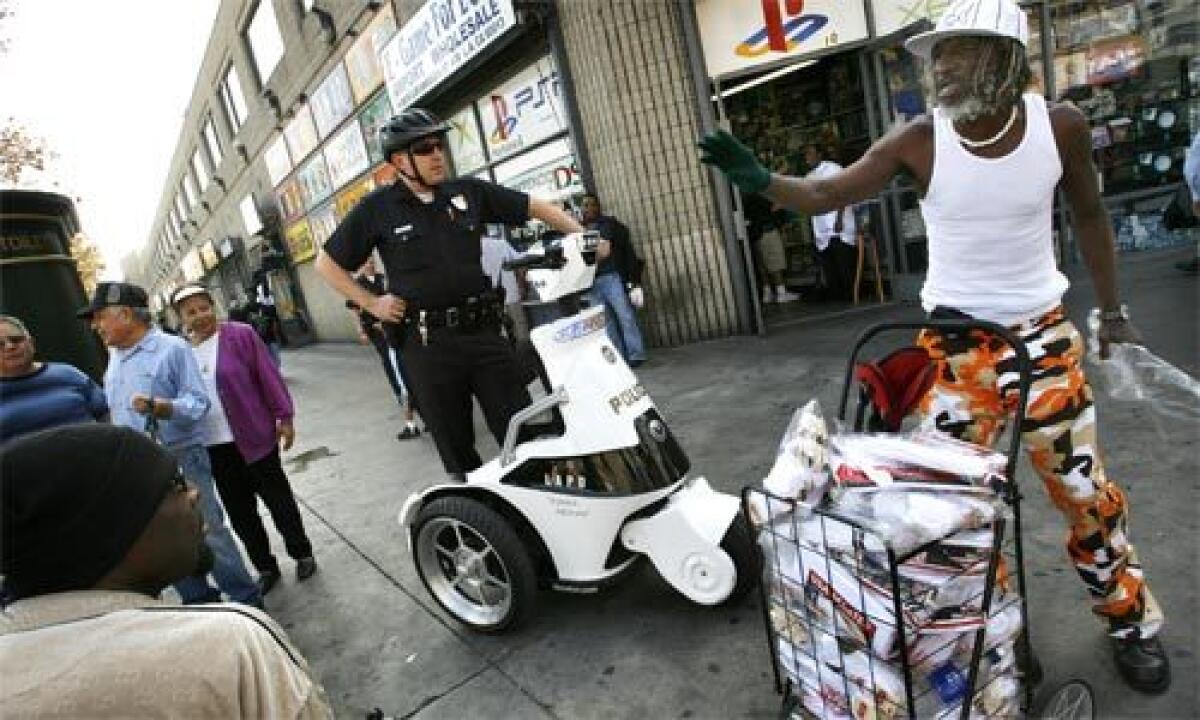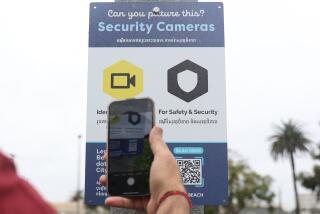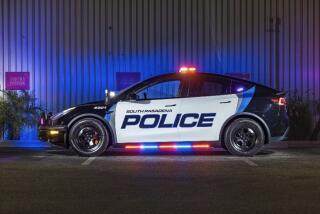LAPD scoots into the future

With red-and-blue lights flashing and sirens wailing, LAPD Officers Garrett Breegle and Paul Rodriguez were hurtling into law enforcementâs future.
Maybe hurtling is not the right word. Breegle and Rodriguez were doing all of 10 mph as they patrolled the area between downtownâs toy and flower districts.
They were aboard Space Age-looking scooters that have come to symbolize the high-tech turn that police work is taking in Los Angeles.
âItâs Robo Cop!â someone shouted as the pair turned from 5th Street onto Los Angeles Street. A small crowd gathered when they pulled to a stop. Then the questions started flying.
âIs this a Segway?â a man asked Breegle. No, itâs a T3 personal mobility vehicle, he responded. âHow fast can you go?â another asked Rodriguez. About 25 mph, he answered.
With their high-intensity, light-emitting diode flashers, squad-car paint scheme and LAPD decals, these battery-driven three-wheelers are tire-squealers.
And they are not the only attention-grabbers being rolled out by police.
Reacting to communication mix-ups between protest marchers and officers during the May 1 MacArthur Park melee, police have unveiled a mobile message board that they call their Critical Incident Utility Vehicle.
Mounted atop a four-wheel-drive all-terrain vehicle, the lighted sign can be programmed from a hand-held wireless device 350 feet away to display information and instructions in various languages.
And then thereâs the LAPDâs Smart Car. Itâs equipped to automatically sniff out stolen cars, recognize criminals, track fleeing suspects and conduct remote video surveillance in high-crime areas.
So far, the department has only one super squad car, but itâs building another. In the meantime, bits and pieces of Smart Car technology are popping up in patrol cars throughout the city:
âPolice cars over the last 15 or 20 years hadnât changed much -- they were just used to get officers from point A to point B and to store equipment,â said Sgt. Dan Gomez, who runs the departmentâs office of tactical technology. Not anymore:
* Automatic license plate recognition cameras can identify stolen cars while officers are patrolling. The computerized cameras read license numbers on either side of and up to two car lengths ahead of the police vehicle. In a six-month test, officers using the equipment recovered 200 âparked stolensâ and 40 ârolling stolens,â Gomez said.
* A dart-gun-like projectile shooter that fires a global positioning system tracking device at a fleeing car. The electronic monitor clamps onto the rear of the car, allowing officers to discontinue the chase and safely follow the suspect using satellite tracking technology. Operated by compressed air, the âStarChaseâ system is mounted in the patrol carâs front grille. Gomez said it can fire the projectile about 20 feet.
* Video receivers that can connect to closed-circuit TV cameras set up in high-crime areas. Officers responding to emergency calls in those areas can operate the cameras and observe the situation âin real timeâ before they arrive, Gomez said. So far, the cameras are set up around the Jordan Downs housing project in the Watts area, he said. Five other patrol cars in that area also have the video capability.
* Specialized computers that allow suspectsâ fingerprints to be scanned and checked in the field. Wireless Bluetooth technology connects the cruiserâs computer to a database that contains the fingerprints of those with outstanding arrest warrants.
* Facial recognition equipment that can identify known suspects. The system has been used in the departmentâs Rampart Division and has resulted in more than 50 arrests, mostly for gang injunction warrants, Gomez said.
* In-car video cameras that record windshield views and activities in the patrol carâs back seat. The system automatically uploads its images when the car returns to the police station. About 300 police cars in the departmentâs South Bureau are being equipped with the camera gear.
Gomez said the equipment adds as much as $100,000 to the standard $25,000 cost of a new patrol car. Although the cost is expected to drop eventually, the timetable for citywide distribution of Smart Cars is uncertain, he said.
âIt has to still be affordable,â he said, adding that Chief William J. Bratton supports the Los Angeles Police Department being a test center for emerging technologies on the theory that widespread use of new equipment will drive prices down for all law enforcement agencies.
Some of the attempts at innovation work better in theory than on the street, however. Thatâs why the jury is still apparently out on the Critical Incident Utility Vehicle.
Police used it at a protest march along downtownâs Broadway. With its rooftop message board flashing an admonition to protesters to âremain on Broadway,â the bright red cart was driven at the head of the march.
âItâs a very effective tool with its signage and voice commands. It can go up and down curbs. But some of the organizers donât like it because they donât want it to look like itâs our parade,â said Capt. Jodi Wakefield, of downtownâs Central Division.
More popular are the T3 scooters. Four of them are being tested at Wakefieldâs station as police ponder the purchase of a fleet of them for use citywide.
The $8,000 scooters are manufactured by T3 Motion in Costa Mesa. Introduced a year ago, they are also used by the Los Angeles County and Orange County sheriffsâ departments, USC, the Port of L.A. and police departments in Irvine, Glendale and Monrovia.
The scooters have a 25-mile range and can be recharged in four hours -- or instantly if slide-out batteries are swapped for charged ones, said company President Neil Brooker.
Unlike the two-wheeled Segway personal transporter and another battery-run, three-wheeled scooter developed by American Chariot of San Leandro, the T3 is not sold to the public, Brooker said.
The Los Angeles County Sheriffâs Department has purchased 25 of them for use at community college campuses and transit centers. They have also been used in West Hollywood, Palmdale and on Santa Catalina Island.
âThe first day they were put to use in Palmdale, deputies credited them for catching two robbery suspects,â said Deputy Paul Schrader.
Monrovia police use their lone T-3 to patrol the cityâs Friday night street fairs. Officers keep the speed under 12 mph. That way they donât have to wear helmets when they maneuver through the fairsâ crowds, said Police Lt. Richard Wagnon.
Los Angeles police say the bicycle helmets they must wear while driving the T3 are a turnoff, adding a dorky look to an otherwise sleek machine.
âWeâre working on the helmet issue,â said Police Sgt. Kevin Royce.
Officers Rodriguez and Breegle said theyâve made traffic stops on their T3s. They said the scooters give officers an extra foot of height, making it easier to see over crowds. And they donât mind the nonstop barrage of questions from passersby.
Shopper Heather Green of Los Angeles gave the scooters a thumbs up.
âTheyâre not intimidating. But they have a professional look,â she said.
More to Read
Sign up for Essential California
The most important California stories and recommendations in your inbox every morning.
You may occasionally receive promotional content from the Los Angeles Times.











